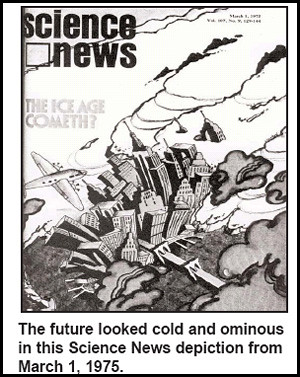Warren Meyer berättar att tidningen Ihtaca Journal undersöker "what burning carbon dioxide is doing to change our world, so we can make more informed choices about how best to ‘go green' as individuals".
Okej, here we go (bilderna lade jag till):
"Positive Feedback Cycles
Our world is full of positive feedback cycles, and so is our society. Popular children's books like “If You Give a Mouse a Cookie” by Laura Numeroff are excellent examples. In Numeroff's tale, a mouse asks for a cookie, leading it to ask for a glass of milk, and so on, till finally it asks for another cookie.Here's an example everyone in Ithaca can relate to: the snowball. If you make a small snowball and set it on the top of a hill, what happens? 1) It begins rolling, and 2) it collects snow as it rolls. When it collects snow, the snowball becomes heavier, which causes gravity to pull on it with more force, making the snowball roll faster down the hill. This causes more snow to collect on the snowball faster, etc., etc. Get the picture? That is a positive feedback cycle. And what happens to the snowball? Eventually the hill flattens and the ball comes to a stop. But if the hill continued forever, the snowball would reach some critical threshold. It would become too big to hold itself together at the raging speed it was traveling down the hill and it would fall apart. Before the snowball formed, it was at equilibrium with its surroundings, and after it falls apart, it may again reach an equilibrium, but the journey is fast-paced and unpredictable.
Carbon dioxide today functions in much the same way as the hill does in our snowball discussion. ..."
Kan ni tänka er, nu är ni experter på hur CO2 i atmosfären fungerar! Mark Lynas har nog inget att invända. :-)
Sen tas upp att vattenångan är en positiv feedback (tråkigt att Aqua-satelliten visat motsatsen) och att istäcket på jorden är en viktig feedback (tyvärr är ismassan nu nära genomsnittet sedan 1979 då mätningarna började).
Meyer kommenterar Ihtaca Journal:
"Only by assuming unbelievably high positive feedback numbers does the IPCC and other climate modelers get catastrophic warming forecasts. Such an assumption is hard to swallow - very few (like, zero) long-term stable natural processes (like climate) are dominated by high positive feedbacks (the IPCC forecasts assume 67-80% feedback factors, leading to forecasts 3x to 5x higher)."Vidare:
"Two problems: 1) In nature, "hills" are never infinitely long. And any hills that are infinitely long with minimal starting energy would find everything at the bottom of the hill long before we came into being 12 billion years or so into the history of the universe. 2) Climate is a long-term quite stable process. It oscillates some, but never runs away. Temperatures in the past have already been many degrees higher and lower than they are today. If a degree or so is all it takes to start the climate snowball running down the infinite hill, then the climate should have already run down this hill in the past, but it never has. That is because long-term stable natural processes are generally dominated by negative, not positive, feedback."
Meyer har förresten gjort några pedagogiska filmklipp om inte minst klimatmodellernas feedback. Detta är senaste och kortaste klippet:
Den hypotes som klimatmodellerna bygger på, är att värme från CO2 styr bl a den betydligt kraftigare växthusgasen vattenånga, så att 1 grad från CO2 (till den totala växthuseffekten på 33 grader) får inte minst moln och vattenånga att reagera så att temperaturökningen blir flera gånger högre. Detta antogs för moln p g a misstolkning av orsak-verkan-samband mellan moln och temperatur (se Spencer), och för vattenånga antogs det utan vidare att atmosfären håller mer sådan när den är varmare, där alltså satellit-observationer visat att vattenångan minskar vid en varmare atmosfär (beroende på ökad nederbörd).
Betänk att dominerande negativ feedback -- istället för av IPCC antagen positiv -- snarast bör ge några tiondels grader uppvärmning ...utan tipping points.
---------------------------------------------------------------------------------
Andra bloggar om: miljö, vetenskap, klimat, klimatet, temperatur, klimatförändring, växthuseffekten, humor


 Climategate -- The Crutape Letters, by Steven Mosher and Thomas W. Fuller
Climategate -- The Crutape Letters, by Steven Mosher and Thomas W. Fuller
 The Deniers
The Deniers


No comments:
Post a Comment
Anonyma, hitta på och ange signatur. Annars gäller att någorlunda hålla sig till ämnet och visa vanlig hyfs.
Note: Only a member of this blog may post a comment.